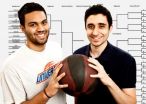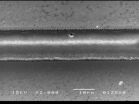(Press-News.org) Scientists have long puzzled over the many hours we spend in light, dreamless slumber. But a new study from the University of California, Berkeley, suggests we're busy recharging our brain's learning capacity during this traditionally undervalued phase of sleep, which can take up half the night.
UC Berkeley researchers have found compelling evidence that bursts of brain waves known as "sleep spindles" may be networking between key regions of the brain to clear a path to learning. These electrical impulses help to shift fact-based memories from the brain's hippocampus – which has limited storage space – to the prefrontal cortex's "hard drive," thus freeing up the hippocampus to take in fresh data. Spindles are fast pulses of electricity generated during non-REM sleep, and they can occur up to 1,000 times a night.
"All these pieces of the puzzle tell a consistent and compelling story – that sleep spindles predict learning refreshment," said Matthew Walker, associate professor of psychology and neuroscience at UC Berkeley and senior author of the study to be published March 8 in the journal Current Biology.
The study found that this spindle-driven networking was most likely to happen during Stage 2 of non-Rapid Eye Movement (NREM) sleep, which occurs before we reach the deepest NREM sleep and the dream state known as Rapid Eye Movement (REM) sleep. This shallow stage of dreamless slumber can account for half our sleeping hours, and happens most frequently during the second half of the night, or in the latter part of a period in which we sleep.
"A lot of that spindle-rich sleep is occurring the second half of the night, so if you sleep six hours or less, you are shortchanging yourself. You will have fewer spindles, and you might not be able to learn as much," said Bryce Mander, a post-doctoral fellow in psychology at UC Berkeley and lead author of the study.
As for broader societal ramifications, researchers said evidence that brain waves during the latter part of the sleep period promote our capacity to store fact-based memories raises the question of whether the early school day is optimal for learning.
"These findings further highlight the importance of sleep in our educational populations, where the need for learning is great, yet late bedtimes and early school start times prevent adequate sleep amounts," Mander said.
On average, adults spend one-third of their lives sleeping. Yet, no scientific consensus has been reached on why humans need sleep, Walker said. Previous research led by Walker has shown that a good night's rest helps us regulate our moods and cope with emotional challenges, while sleep deprivation can make otherwise reasonable people emotionally shaky, indicating a strong correlation between sleep loss and psychiatric disorders.
For this latest study, Walker and his team took 44 healthy young adults and subjected them to a rigorous memorizing task intended to tax the hippocampus. All participants performed at similar levels. The group was then divided, with one half taking a 90-minute nap while the other half stayed awake.
That evening, the entire group was subjected to another round of learning. The ability to memorize new information deteriorated for those who had remained awake throughout the day. In contrast, those who had napped not only performed better than the waking group, but actually improved their capability for learning, as if sleep had refreshed their memory capacity, the study found.
Electroencephalogram tests, which measured electrical activity in the brains of the nappers, showed that the more sleep spindles the nappers produced, the more refreshed they were for learning. Furthermore, researchers were able to link sleep spindles to brain activity looping between the lobes of the brain that house the hippocampus and prefrontal cortex – two critical areas for memory.
"Our findings demonstrate that sleep may selectively seek out and operate on our memory systems to restore their critical functions," Walker said.
"This discovery indicates that we not only need sleep after learning to consolidate what we've memorized, but that we also need it before learning, so that we can recharge and soak up new information the next day."
###
UC Berkeley psychology students Sangeetha Santhanam and Jared M. Saletin are co-investigators in the study.
As we sleep, speedy brain waves boost our ability to learn
A UC Berkeley study suggests we're busy recharging our brain’s learning capacity during a dreamless light slumber that takes up half our sleeping hours
2011-03-09
ELSE PRESS RELEASES FROM THIS DATE:
How long does a tuning fork ring?
2011-03-09
This release is available in German.
From the wooden bars in a xylophone or the head of a drum, to the strings and sound box of a guitar or violin, musical instruments are the most familiar examples of mechanical resonators. The actual mechanical vibrations of these instruments create acoustic waves that we hear as sound. The purity of the emitted tone is intimately related to the decay of the vibration amplitude, that is, the mechanical losses of the system. A figure of merit for mechanical losses is the quality factor, simply called "Q", which describes the number ...
First census finds surprisingly few white sharks off California
2011-03-09
In the first census of its kind, research led by UC Davis and Stanford University found that there are far fewer white sharks off central California than biologists had thought.
The study, published today in the journal Biology Letters, is the first rigorous scientific estimate of white shark numbers in the northeast Pacific Ocean. It is also the best estimate among the world's three known white-shark populations (the others are in Australia/New Zealand and South Africa).
The researchers went out into the Pacific Ocean in small boats to places where white sharks congregate. ...
Cleansing the soul by hurting the flesh: The guilt-reducing effect of pain
2011-03-09
Lent in the Christian tradition is a time of sacrifice and penance. It also is a period of purification and enlightenment. Pain purifies. It atones for sin and cleanses the soul. Or at least that's the idea. Theological questions aside, can self-inflicted pain really alleviate the guilt associated with immoral acts? A new study published in Psychological Science, a journal of the Association for Psychological Science, explores the psychological consequences of experiencing bodily pain.
Psychological scientist Brock Bastian of the University of Queensland, Australia and ...
March GSA Today: The case for a neoproterozoic oxygenation event
2011-03-09
The Cambrian "explosion" of multicellular animal life is one of the most significant evolutionary events in Earth's history. But what was it that jolted the Earth system enough to prompt the evolution of animals? While we take the presence of oxygen in our atmosphere for granted, it was not always this way.
The Neoproterozoic era that preceded the Cambrian explosion of life was witness to a dramatic rise in oxygen levels. It has been widely assumed that the rise in atmospheric oxygen was the essential precursor to the evolution of animals. But the work of Graham Shields-Zhou ...
UNC study finds oral tongue cancer increasing in young, white females
2011-03-09
Chapel Hill, NC – A UNC study released this week in the Journal of Clinical Oncology finds an increasing incidence of squamous cell carcinoma of the oral tongue in young white females in the United States over the last three decades.
A team of researchers from UNC Lineberger Comprehensive Cancer Center analyzed data from the National Cancer Institute's Surveillance, Epidemiology and End Results (SEER) database and found that, between 1975 and 2007, the overall incidence for all ages, genders, and races of the disease was decreasing. However, the incidence of oral tongue ...
Real March Madness is relying on seedings to determine Final 4
2011-03-09
CHAMPAIGN, Ill. — Think picking all the top-seeded teams as the Final Four in your March Madness bracket is your best bet for winning the office pool? Think again.
According to an operations research analysis model developed by Sheldon H. Jacobson, a professor of computer science and the director of the simulation and optimization laboratory at the University of Illinois, you're better off picking a combination of two top-seeded teams, a No. 2 seed and a No. 3 seed.
"There are patterns that exist in the seeds," Jacobson says. "As much as we like to believe otherwise, ...
It's all in a name: 'Global warming' vs. 'climate change'
2011-03-09
ANN ARBOR, Mich.---Many Americans are skeptical about whether the world's weather is changing, but apparently the degree of skepticism varies systematically depending on what that change is called.
According to a University of Michigan study published in the forthcoming issue of Public Opinion Quarterly, more people believe in "climate change" than in "global warming."
"Wording matters," said Jonathon Schuldt, the lead author of the article about the study and a doctoral candidate in the U-M Department of Psychology.
Schuldt co-authored the study with U-M psychologists ...
Ultrafast laser 'scribing' technique to cut cost, hike efficiency of solar cells
2011-03-09
WEST LAFAYETTE, Ind. - Researchers are developing a technology that aims to help make solar cells more affordable and efficient by using a new manufacturing method that employs an ultrafast pulsing laser.
The innovation may help to overcome two major obstacles that hinder widespread adoption of solar cells: the need to reduce manufacturing costs and increase the efficiency of converting sunlight into an electric current, said Yung Shin, a professor of mechanical engineering and director of Purdue University's Center for Laser-Based Manufacturing.
Critical to both are ...
Oldest known wild bird in US returns to Midway to raise chick
2011-03-09
MIDWAY ATOLL — The oldest known U.S. wild bird – a coyly conservative 60 -- is a new mother.
The bird, a Laysan albatross named Wisdom, was spotted a few weeks ago with a chick by John Klavitter, a U.S. Fish and Wildlife Service biologist and the deputy manager of the Midway Atoll National Wildlife Refuge.
The bird has sported and worn out 5 bird bands since she was first banded by U.S. Geological Survey scientist Chandler Robbins in 1956 as she incubated an egg. Chandler rediscovered Wisdom in 2001. In 1956, he estimated Wisdom to be at least 5 years old then since ...
NYSCF – Robertson investigator publishes research to better understand pluripotent stem cells
2011-03-09
NEW YORK CITY (March 7, 2011)— Paul Tesar, PhD, of Case Western Reserve University, a member of the inaugural class of The New York Stem Cell Foundation – Robertson Investigators, published his research on the ability to isolate epiblast stem cells from preimplantation mouse embryos. This research enhances our understanding of the many forms of pluriportent stem cells that scientists use for researching so many debilitating diseases.
"I think that this paper will change the way people think about what human ES cells represent from a developmental perspective," said Dr. ...
LAST 30 PRESS RELEASES:
Making lighter work of calculating fluid and heat flow
Normalizing blood sugar can halve heart attack risk
Lowering blood sugar cuts heart attack risk in people with prediabetes
Study links genetic variants to risk of blinding eye disease in premature infants
Non-opioid ‘pain sponge’ therapy halts cartilage degeneration and relieves chronic pain
AI can pick up cultural values by mimicking how kids learn
China’s ecological redlines offer fast track to 30 x 30 global conservation goal
Invisible indoor threats: emerging household contaminants and their growing risks to human health
Adding antibody treatment to chemo boosts outcomes for children with rare cancer
Germline pathogenic variants among women without a history of breast cancer
Tanning beds triple melanoma risk, potentially causing broad DNA damage
Unique bond identified as key to viral infection speed
Indoor tanning makes youthful skin much older on a genetic level
Mouse model sheds new light on the causes and potential solutions to human GI problems linked to muscular dystrophy
The Journal of Nuclear Medicine ahead-of-print tip sheet: December 12, 2025
Smarter tools for peering into the microscopic world
Applications open for funding to conduct research in the Kinsey Institute archives
Global measure underestimates the severity of food insecurity
Child survivors of critical illness are missing out on timely follow up care
Risk-based vs annual breast cancer screening / the WISDOM randomized clinical trial
University of Toronto launches Electric Vehicle Innovation Ontario to accelerate advanced EV technologies and build Canada’s innovation advantage
Early relapse predicts poor outcomes in aggressive blood cancer
American College of Lifestyle Medicine applauds two CMS models aligned with lifestyle medicine practice and reimbursement
Clinical trial finds cannabis use not a barrier to quitting nicotine vaping
Supplemental nutrition assistance program policies and food insecurity
Switching immune cells to “night mode” could limit damage after a heart attack, study suggests
URI-based Global RIghts Project report spotlights continued troubling trends in worldwide inhumane treatment
Neutrophils are less aggressive at night, explaining why nighttime heart attacks cause less damage than daytime events
Menopausal hormone therapy may not pose breast cancer risk for women with BRCA mutations
Mobile health tool may improve quality of life for adolescent and young adult breast cancer survivors
[Press-News.org] As we sleep, speedy brain waves boost our ability to learnA UC Berkeley study suggests we're busy recharging our brain’s learning capacity during a dreamless light slumber that takes up half our sleeping hours


